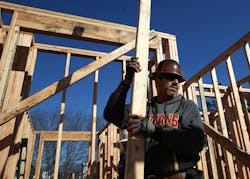Project Costs: How Far is Up?
Electrical contractors and their suppliers have plenty to kvetch about when it comes to the increases in steel and aluminum prices and the wild ride that copper prices have been on over the last few months. However, they don’t have it nearly as bad as builders or suppliers and manufacturers that live and die with the prices of other construction-related products in the supply chain.
These folks are not only getting whacked by double-digit price increases for steel products (e.g., rebar and framing materials), aluminum products (e.g., window frames), #2 diesel fuel, asphalt, and lumber, but also by labor shortages throughout the construction trades — derailing the construction schedules for all sorts of projects. On top of rising materials costs and labor shortage, hopped-up end-user demand for new buildings and renovations in a healthy construction market is also fueling the increases.
Higher costs of materials increase project prices
While few general contractors are willing to say increases in project costs are solely due to the current 25% tariff on steel and 10% tariff on aluminum because of the other contributing factors mentioned above, there’s little doubt they are at least a contributing factor. An August post at www.king5.com and a recent Bloomberg report said two major construction projects in Seattle are way over budget because of material costs and the labor shortage. A representative from the Oak View Group, a Los Angeles-based developer working on a new arena at Seattle Center, said the cost for that facility had gone up from $600 million to $700 million, in part because of higher steel costs. Furthermore, the Federal Way Link Light Rail project is substantially over budget, according to a post at www.king5.com. “We’re looking at about a $460 million increase in that project estimate,” Scott Thompson of Sound Transit said in the post. “Material costs have risen, and right now we’re looking at the risk and challenges on tariffs like steel and aluminum as well.”
The Associated General Contractors of America (AGC) is quite concerned with the impact of the tariffs on its members and has been publishing regular reports on increases in prices for core construction products. And while the price increases seem to have simmered down some in mid-August from where they were in Q2 2018, AGC’s Chief Economist Ken Simonson said they are still having a big impact on the construction industry and the profits of AGC members. Simonson said in a recent AGC press release, “Although price changes for construction materials in July were mixed, contractors are likely to be hit with additional cost increases as new tariffs take hold and stocks of items purchased before the tariffs are used up,” he said. “Despite the pause in cost increases in July, prices for goods and services used in construction rose over the past year at more than double the rate that contractors have raised their bid prices to put up new buildings.”
He also said in the press release that the producer price index for inputs to construction industries — a weighted average of all goods and services used in construction (including items consumed by contractors, such as diesel fuel) — was unchanged from June to July but jumped +8.1% since July 2017. “Steel, aluminum, and Canadian lumber are all subject to stiff new tariffs, with the prospect that prices will soon rise even more for these and other goods used in construction,” Simonson said. “In addition, the cost of delivering goods and equipment to construction sites, operating diesel-powered equipment, and hauling away dirt, debris, and equipment is affected by fast-rising prices for fuel and trucking services.”
Despite the current respite from more dramatic price hikes, some key construction-related products are still saddled with eye-catching year-over-year increases, as measured by the U.S. government’s Producer Price Index (PPI). The AGC release noted several of the products with the biggest gains through July 2018, including diesel fuel, metals, and wood products:
• Diesel fuel: +43.6%
• Aluminum mill shapes: +17.8%
• Lumber and wood plywood: +16.3%
• Steel mill products: +12.4%
Tariffs on Canadian lumber hammer homebuilders
In the homebuilding market, construction of single-family homes and multi-family apartments, condos, and townhouses is so healthy in many markets that builders can’t find enough skilled framers, masons, plumbers, electricians, and other craftsmen. On top of that problem, the tariffs on Canadian lumber have driven up prices. In the Eye on Housing blog published by the National Association of Home Builders (NAHB), David Logan wrote, “July marked the first time in seven months that the price index for residential construction inputs (goods) did not increase. Still, the index has risen 5.4% in 2018, more than quadrupling the year-to-date increase at this time in 2017.
“Since January 2017, the index for prices paid for goods inputs to residential construction has only declined twice — in May and December of 2017 — each time falling just 0.1%. As expected, the July Producer Price Index release captured the decreases in prices paid for softwood lumber that began in mid-June. This was only the second month in 2018 in which the index for softwood lumber has declined. Even after accounting for the most recent price movements, the average price paid for softwood lumber in 2018 remains the highest on record, according to Random Lengths (www.randomlengths.com) data — 22.8% above the prior record set in 1997.”
And according to a report posted at www.housingwire.com, Robert Dietz, NAHB’s chief economist, told attendees at the recent National Association of Real Estate Editors conference in Las Vegas that the 20% tariffs placed on Canadian softwood lumber last year have increased the average cost of a new home for home buyers. According to www.housingwire.com, Dietz said, “A lumber tariff is very much a tax on homeowners and renters. In fact, it’s pushed up the price of a typical newly built home, according to our survey data analysis, by about $9,000. It’s pushed up the price of a typical apartment by about $3,000.”
NAHB has lobbied the Administration on this issue. NAHB Chairman Randy Noel, a custom home builder from LaPlace, La., said in a recent NAHB press release, “We have been warning the Administration for months that the ongoing increases in lumber prices stemming from both the tariffs and profiteering this year are having a strong impact on builders’ ability to meet growing consumer demand. This is why we continue to urge senior officials to take leadership and resolve this issue.”
Rising cost of steel and aluminum takes bite out of N.Y. condo craze
A recent article in the New York Times said the steel and aluminum tariffs are having a direct impact on the cost of materials used to build apartments and condos in the city — and are driving up sale prices. According to the article, a 20-story apartment building can require 1.5-million pounds of rebar, and prices for domestic raw rebar through late July had increased 15% to 39 cents/pound from 34 cents/pound earlier in 2018. New York builders are getting squeezed by aluminum prices, too, the article reported.
That same apartment building may also require 150,000 pounds of aluminum, (largely for window frames), and aluminum prices were up 32% from March to April before settling down to somewhat more manageable levels this summer.
Electrical contractors and other construction industry veterans have been through roller coaster pricing cycles before, and these cycles always inject a certain amount of uncertainty and delays in the market because contractors from all the building trades can’t get a workable idea of what materials will cost and how long quotes for materials will be in effect.
About the Author
Jim Lucy
Editor-in-Chief, Electrical Wholesaling & Electrical Marketing
Over the past 40-plus years, hundreds of Jim’s articles have been published in Electrical Wholesaling, Electrical Marketing newsletter and Electrical Construction & Maintenance magazine on topics such as electric vehicles, solar and wind development, energy-efficient lighting and local market economics. In addition to his published work, Jim regularly gives presentations on these topics to C-suite executives, industry groups and investment analysts.
He launched a new subscription-based data product for Electrical Marketing that offers electrical sales potential estimates and related market data for more than 300 metropolitan areas. In 1999, he published his first book, “The Electrical Marketer’s Survival Guide” for electrical industry executives looking for an overview of key market trends.
While managing Electrical Wholesaling’s editorial operations, Jim and the publication’s staff won several Jesse H. Neal awards for editorial excellence, the highest honor in the business press, and numerous national and regional awards from the American Society of Business Press Editors. He has a master’s degree in communications and a bachelor’s degree in journalism from Glassboro State College, Glassboro, N.J. (now Rowan University) and studied electrical design at New York University and graphic design at the School for Visual Arts.



